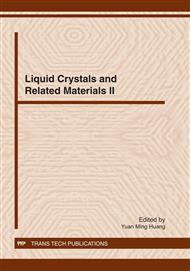[1]
J. R. Heath and M. A. Ratner: Phys. Today Vol. 56 (2003), p.43.
Google Scholar
[2]
A. Halbritter, S. Csonka, G. Mihaly, E. Jurdik, O. Y. Kolesnychenko, O. I. Shklyarevskii, S. Speller and H. van Kempen: Phys. Rev. B Vol. 68 (2003), p.035417.
DOI: 10.1103/physrevb.68.035417
Google Scholar
[3]
M. A. Reed, C. Zhou, C. J. Muller, T. P. Burgin and J. M. Tour: Science Vol. 278 (1997), p.252.
Google Scholar
[4]
R. H. M. Smit, Y. Noat, C. Untiedt, N. D. Lang et al.: Nature (London) Vol. 419 (2002), p.906.
Google Scholar
[5]
A. N. Pasupathy, R. C. Bialczak, J. Martinek, L.A.K. Donev, P.L. McEuen and D.C. Ralph: Science Vol. 306 (2004), p.86.
DOI: 10.1126/science.1102068
Google Scholar
[6]
Y. Girard, M. Kondo and K. Yoshizawa: Chem. Phys. Vol. 327 (2006), p.77.
Google Scholar
[7]
X. Q. Shi, X. H. Zheng, Z. X. Dai,Y. Wang and Z. Zeng: J. Phys. Chem. B Vol. 109 (2005), p.3334.
Google Scholar
[8]
M. Kondo, T. Tada and K. Yoshizawa: J. Phys. Chem. A Vol. 108 (2004), p.9143.
Google Scholar
[9]
P. Pati and S. P. Karna: Phys. Rev. B Vol. 69 (2004) p.155419.
Google Scholar
[10]
G. Emberly and G. Kirczenow: Phys. Rev. Lett. Vol. 91 (2003), p.188301.
Google Scholar
[11]
Y. Karzazi, J. Cornil and J. L. Bredas: J. Am. Chem. Soc. Vol. 123 (2001), p.10076.
Google Scholar
[12]
J. Taylor, M. Brandbyge and K. Stokbro: Phys. Rev. B Vol. 68 (2003), p.121101.
Google Scholar
[13]
Y. Luo and Y. Fu: J. Chem. Phys. Vol. 117 (2002), p.10283.
Google Scholar
[14]
C. Zhang, M. H. Du, H. P. Cheng et al.: Phys. Rev. Lett. Vol. 92(2006) p.158301.
Google Scholar
[15]
X. Q. Shi, X. H. Zheng, Z. X. Dai et al.: J. Phys. Chem. B Vol. 109 (2005), p.3334.
Google Scholar
[16]
M. Brandbyge, J. -L. Mozos et al.: Phys. Rev. B Vol. 65 (2002), p.165401.
Google Scholar
[17]
Z. H. Zhang, Z. Yang, J. H. Yuan and X. Q. Deng: J. Chem. Phys. Vol. 129 (2008), p.094702.
Google Scholar
[18]
Z. H. Zhang, Q. Z. Yang, J. H. Yuan and M. Qiu: Chin. Sci. Bull. Vol. 52 (2007), p.10.
Google Scholar


